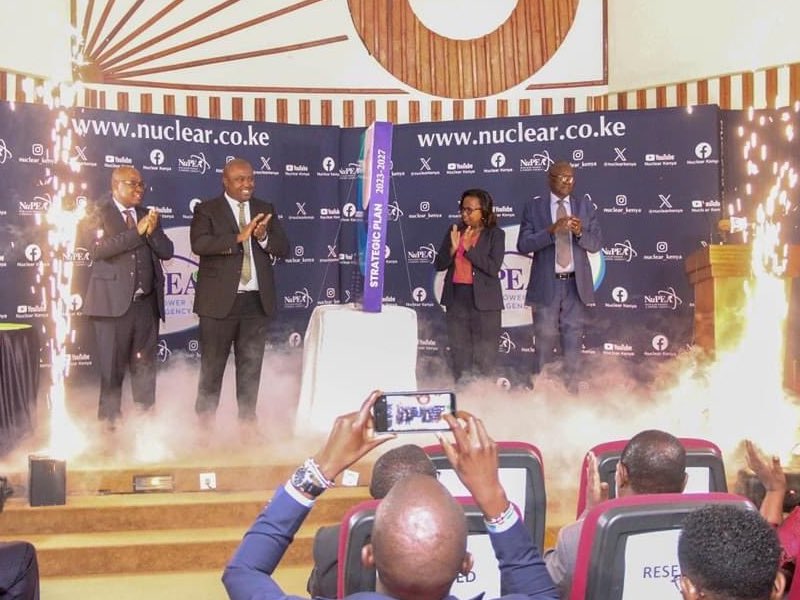Kenya has released its nuclear energy roadmap as it aims to commission its first research reactor within the next 10 years.
It was launched this week by the Nuclear Power and Energy Agency (NuPEA). Strategic plan 2023-2027 sets out the country’s nuclear energy ambitions.
Alex Wachira, Secretary General of the Ministry of Energy and Petroleum, said the plan provides guidelines for the development of nuclear infrastructure.
This will extend to the construction, operation, maintenance and operation of nuclear facilities in a safe and secure manner.
“The strategic plan proposes practical interventions to ensure that Kenya begins construction of its first nuclear power plant in 2027 and commissions it in 2034,” Wachira said.
Kenya’s domestic installed electricity capacity is about 3,073 MW. It consists of hydro (839 MW), geothermal (940 MW), thermal (646 MW), wind (436 MW) and solar (210 MW). The rest is made up of biomass.
Have you read it?
Kenya sees nuclear power as the continent’s “last best hope”.
Kenya is looking to add nuclear power to this electricity generation mix.
NuPEA CEO Justus Wabuyabo said the strategy would ensure Kenya’s adherence to international conventions, treaties and obligations governing nuclear applications, radiation protection, radioactive material and nuclear waste transport.
The plan also contains procedures for creating a legal framework and a human resource development plan to ensure that nuclear power becomes a key component of the country’s energy mix, he said.
Wachura said this roadmap will guide the Agency and the industry over the next five years; “As we strive to fulfill Kenya’s mission to harness the power of nuclear energy for the betterment of our society and the advancement of our nation.”
Experts inspect Kenya’s nuclear infrastructure
In January, NuPEA hosted a Site and External Event Design (SEED) review mission for Kenya’s nuclear research reactor in Nairobi.
Research reactors are nuclear facilities that primarily serve as a neutron source for a variety of applications in education and training, research, health, agriculture and industry, NuPEA noted.
NuPEA requested that a review mission be conducted by the International Atomic Energy Agency (IAEA) and a team of international experts.
Have you read it?
Data on nuclear energy. Global Status Report of the Nuclear Industry 2023
The SEED missions developed by the IAEA are intended to assist Member States in aspects related to site security and to protect “nuclear installations at various stages from external events”.
The IAEA also visited Kenya in December at the direction of the government.
“Kenya has made significant progress in developing the national nuclear infrastructure for the country’s new research reactor program,” the IAEA review mission said.
They were on a nine-day mission to review preparations for the research reactor program.
IAEA Report Card
The Integrated Nuclear Infrastructure Review of Research Reactors (INNIR-RR) took place from December 11 to 19, 2023. The Kenyan government invited the mission to conduct a review.
The mission team members reviewed the status of the country’s nuclear infrastructure development in accordance with the criteria and conditions of Phase 1 of the IAEA’s Research Reactor Milestones approach.
“Some countries embarking on a nuclear power program, including Kenya, are pursuing the construction of their first research reactor, which can serve as a stepping stone to their future nuclear power program.
“Kenya plans to commission its first research reactor between 2030 and 2037,” the IAEA said.
Have you read it?
The case for nuclear as a clean energy source is gaining momentum
The IAEA team provided suggestions and recommendations for the further development of the nuclear infrastructure of the new research reactor program.
“Kenya has demonstrated a steady and very professional approach to the development of its research reactor program,” said Andrei Sitnikov, who led the IAEA’s review mission and is the technical chief of the IAEA’s research reactor division.
“We noted that before the final decision was made, Kenya did a lot of work in developing and preparing laws and regulatory documents, actively involving stakeholders in the program and developing human resources for both the future operator and the regulator.”
South Africa is currently the only nuclear operator in Africa with two reactors at Koeberg.

